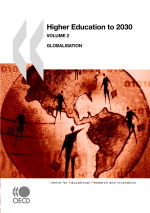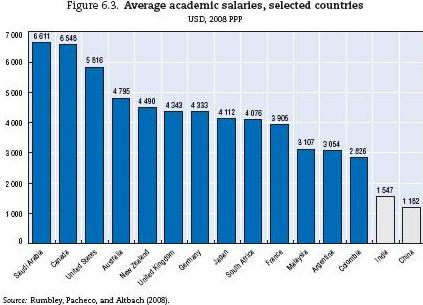Centre for Educational Research and Innovation - CERI
Higher Education to 2030, Volume 2: Globalisation
Executive summary | Table of contents
How to obtain this publication | Related material
|
ISBN:9789264056602 |
Higher Education to 2030, Volume 2: Globalisation Growing flows of knowledge, people and financing cross national borders and feed both worldwide collaboration and competition. These effects of globalisation increasingly impact higher education. How then might the future higher education scene look at the global level? What are the challenges and opportunities brought by globalisation? How can countries and institutions best cope with and benefit from future changes?
Through both quantitative and qualitative analysis, this book provides a comprehensive and structured look at these essential questions. It explores the topic of cross-border higher education in terms of student, faculty and institutional mobility, providing a specific focus on academic research. Other issues addressed include higher education provision, financing, governance and quality assurance, with an emphasis on the use of market-like mechanisms. The book covers most OECD countries as well as many non-OECD countries and offers the reader specific reflections on China, India and European co-operation. Higher Education to 2030 (Vol. 2): Globalisation will be of interest to policy makers, managers of higher education institutions, academics, researchers, and students – as well as to all readers interested in social issues. This is the second volume in the Higher Education to 2030 series, which takes a forward-looking approach to analysing the impact of various contemporary trends on tertiary education systems. Volume 1 examines the effects of demography, while volume 3 explores the effects of technology. The fourth and final volume will present scenarios illustrating the main trends and driving forces for the future of higher education. |
Higher education drives and is driven by globalisation. It trains the highly skilled workers and contributes to the research base and capacity for innovation that determine competitiveness in the knowledge-based global economy. It facilitates international collaboration and cross-cultural exchange. Cross-border flows of ideas, students, faculty and financing, coupled with developments in information and communication technology, are changing the environment where higher education institutions function. Co-operation and competition are intensifying simultaneously under the growing influence of market forces and the emergence of new players. How will global higher education evolve over the next 20 years? How can governments and institutions meet the challenges and make the most of the opportunities?
Higher Education to 2030: Globalisation, the second in a four-volume series, addresses these issues both from a quantitative and a qualitative standpoint. Increased global competition in higher education, simultaneous to cross-border collaboration is illustrated not only on a global scale, but also at a regional level through developments in Europe. Though the emphasis is on the OECD area, the reflections have a worldwide scope with particular emphasis on the potential of China and India. The book explores significant trends in higher education provision, financing and governance, including a specific focus on the future role of market forces, mobility, and quality assurance in higher education. The reviewed trends point towards the possible following key developments in the future.
- Executive summary
- Chapter 1. The new global landscape of nations and institutions
- Chapter 2. Cross-border higher education: trends and perspectives
- Chapter 3. Trends and future scenarios in programme and institution
- Chapter 4. Europeanisation, international rankings and faculty mobility
- Chapter 5. What is changing in academic research? trends and prospects
- Chapter 6. The giants awake: the present and future of higher education systems in China and India
- Chapter 7. European higher education reforms in the context of the Bologna process: how did we get here, where are we and where are we going?
- Chapter 8. Mass higher education and private institutions
- Chapter 9. Finance and provision in higher education: a shift from public to private?
- Chapter 10.Scenarios for financial sustainability of tertiary education
- Chapter 11.Quality assurance in higher education - its global future
|
|
How to obtain this publication
Readers can access the full version of Higher Education to 2030, Volume 2: Globalisation choosing from the following options:
-
Subscribers and readers at subscribing institutions can access the online edition via SourceOECD, our online library.
-
Non-subscribers can purchase the PDF e-book and/or paper copy via our Online Bookshop.Order from your local distributor
-
Government officials with accounts () can go to the "Books" tab on OLIS.

